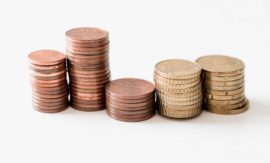Intended learning outcomes: Produce an overview on Determining the process cost rate and process quantity for supplier management. Explain determining the process cost rate as well as the process costs for external procurement of a single item: “standard component” versus “exotic component”.
Figure 16.4.4.1 shows another example, taken again from [Schm92]. Here, “supplier management” is a subprocess of the main process “materials purchasing.”
Fig. 16.4.4.1 Determining the process cost rate and process quantity for supplier management.
The process costs are recorded for a period of time (in this case, six months). The process variable is the supplier. The process cost rate is determined by dividing the process costs by the number of suppliers. The number of different items procured from the supplier and the usage for each of these items over the time period determines process quantity. This provides the process quantity of each component that is incorporated into one product.
Figure 16.4.4.2 provides a quantitative example using simple data for illustrative purposes. It reveals the difference between the process costs for supplier management with just one supplier and a large number of purchased items with a high turnover and the process costs for one supplier with just a few purchased items and a correspondingly lower turnover.
Fig. 16.4.4.2 Determining the process cost rate for a single item in the “supplier management” process: “standard component” versus “exotic component.”
Figure 16.4.4.3 extends the supplier management example to include a costing for the entire purchasing process.
Fig. 16.4.4.3 Determining the process costs for external procurement of a single item: “standard component” versus “exotic component.”
Again, the difference in process costs mentioned above stands out clearly. With conventional costing, in contrast, if the same additional percentage for material costs is applied to both the standard component and the exotic component, the loaded fixed material costs will be the same, even though the one is much more expensive to purchase than the other.
Continuation in next subsection (16.4.4b).
Course section 16.4: Subsections and their intended learning outcomes

16.4 Activity-Based Costing
Intended learning outcomes: Disclose the limits of traditional product costing. Explain activity-based costing: aim, basic premise, requirements, and technique. Present typical processes (activities) and process variables as well as the activity-based product cost estimation.

16.4.1 Limits of Traditional Product Costing
Intended learning outcomes: Describe allocating fixed costs to products with conventional cost accounting using two cost types. Explain the potential for error in traditional product costing.

16.4.2 Activity-Based Costing: Basic Premise, ABC Process, Activity Cost Driver, ABC Process Plan
Intended learning outcomes: Produce an overview on activity-based costing. Identify ABC process, process variable and process cost rate. Describe the ABC process plan and the process quantity.

16.4.2b Allocating Fixed Costs Using Activity-Based Costing, and Introducing ABC
Intended learning outcomes: Explain allocating fixed costs using activity-based cost accounting. Describe the steps to introduce activity-based costing into the company.

16.4.3 Typical Processes (Activities) and Process Variables for Activity-Based Costing
Intended learning outcomes: Explain determining main processes and subprocesses, using the example of circuit board assembly. Describe determining main processes and subprocesses using the example of procurement.

16.4.4 Activity-Based Product Cost Estimation
Intended learning outcomes: Produce an overview on Determining the process cost rate and process quantity for supplier management. Explain determining the process cost rate as well as the process costs for external procurement of a single item: “standard component” versus “exotic component”.

16.4.4b Activity-Based Costing: Examples
Intended learning outcomes: Present in detail an ABC process plan and activity-based product cost estimation for a produced item as well as for a procured item.
